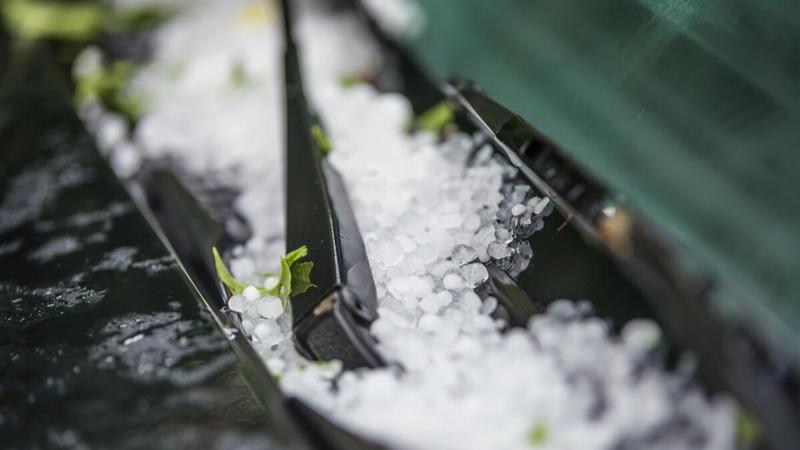When a thunderstorm brews, the threat of hail lingers, and with it, the possibility of property damage. Hailstorms generally occur from May to October in Canada, when the warmer weather creates updrafts, carrying water vapour up to colder altitudes — the perfect recipe for ice pellets.
When the ice pellets get too heavy, they fall as hail. According to Public Safety Canada, hailstones have a minimum diameter of half a centimetre. That is about the diameter of a pushpin. But hailstones can grow larger than 10 centimetres in diameter, which people often say resembles a grapefruit. Moreover, hail can hit the ground at 130 kilometres per hour. That is faster than the highest speed limit found on any road in Canada (120 km/h) — think about that the next time you are on a highway.
So, you can only imagine the extent of the damage the ice travelling at such speeds could cause if it were to collide with your car. Unfortunately, this scenario is too real for many Canadians in Alberta, the Prairies, and Southern Ontario.
Last June, the costliest hailstorm in the country’s history struck Calgary, resulting in approximately 70,000 insurance claims for homes, vehicles, and businesses and more than $1.3 billion in insured damages. Recent storms caused Saskatchewan Government Insurance (SGI) to see nearly 4,000 auto insurance claims at the end of August 2021.
Severe weather events are unpredictable, but you can prepare for the unexpected with the right auto insurance coverage and resources to minimize the financial impact.
How to avoid hail damage to your vehicle
The Insurance Bureau of Canada (IBC) and the Institute for Catastrophic Loss Reduction (ICLR) suggest several ways to keep you and your vehicle safe during a hailstorm. These tips include:
- Monitoring local weather forecasts for severe weather warnings
- Parking your vehicle in a covered area (where possible)
- Seek shelter in a secure building, away from windows
While there are products on the market that claim to be “hail resistant,” such as blankets and covers for your vehicle, they must be deployed ahead of a storm. The ICLR warns that no standards bodies have approved these products, and consumers use these products at their own risk.
What to do if hail damages your car
After the storm, once it is safe to do so, drivers should assess the damage to their vehicles.
Follow these steps to assist with your claim:
- Carefully document all damage with photographs and detailed notes of the locations on your car.
- Write down the date of the storm.
- Call your insurance provider to report the damage and take note of the representative’s name.
Damage to your vehicle should fall under your comprehensive or specified perils coverage.
- Comprehensive: This coverage protects against perils such as theft, vandalism, falling or flying debris, hail, and fire — essentially anything that happens while your vehicle is stationary.
- Specified perils: This coverage protects against perils that are specifically listed on your policy, which may include lightning, hail, rising water, and earthquakes.
However, these are optional coverages and must be added to your policy before any damage occurs.
Should you submit a car insurance claim for hail damage?
As with most insurance policies, drivers must pay a deductible to use their comprehensive coverage. Choosing a higher deductible can lower your premium; however, you’ll pay more out of pocket if you need to file a claim.
If the hail damage to your car is less than your comprehensive deductible (usually $500 to $1,000), then it would not make financial sense to file a claim.
Suppose your vehicle sustains $3,000 worth of damage, and you have a $1,000 deductible. You would pay $1,000, and your insurance company would cover the remaining $2,000.
You also have to consider the age of your vehicle. If the damage costs $1,500 to repair and you have a $1,000 deductible, but your car is only worth $2,500, it may not be worth it. You may be better off putting that money toward a new vehicle.
Choosing whether to get the repairs depends on your circumstances and what makes financial sense. Speaking to your insurance representative can help you make a decision and will not increase your premium.
Are you covered if hail damages your rental car?
If you are caught in a hailstorm in a rental car, you may have coverage if you’ve added an endorsement to your personal auto insurance policy.
If you’re looking for car insurance in Ontario, these endorsements are called Ontario Policy Change Forms (OPCF); if you’re looking for car insurance in Alberta and other provinces, they are referred to as Standard Endorsement Forms (SEF).
- OPCF 27: This endorsement protects drivers from liability for damage to non-owned automobile(s), including rental cars. The coverage usually has a limit of $25,000 to $50,000.
- SEF 27: Similarly, this endorsement protects drivers from liability for damage to non-owned automobile(s), granting the same coverage you currently have on a vehicle you own. Generally, this endorsement only applies to rentals in the U.S. and Canada.
Read your policy carefully, and speak to your broker or agent if anything is unclear. Earlier this year, a woman in B.C. had the misfortune of being caught in the big Calgary hailstorm in a rental truck. She thought she had adequate coverage through her credit card; however, to her dismay, pickup trucks were excluded. In this case, the repairs cost a whopping $4,424.50, and she was stuck with the bill.

